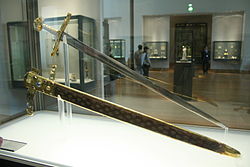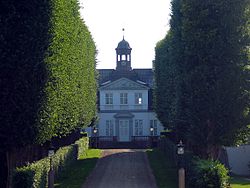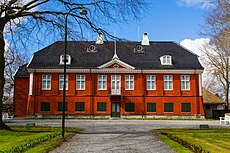Monarchy of Hellona
| King of Hellona | |
|---|---|
| Kᛟᚾᛁᛝ Vᚨᚾ ᚻᛖᛚᛚᚨᚾᚦ | |
 | |
| Incumbent | |
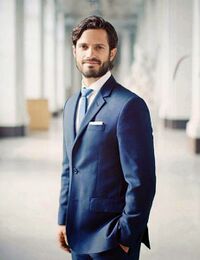 | |
| Kristoffer since 7 October 1953 | |
| Details | |
| Style | His Majesty |
| First monarch | Björn Wodanerson |
| Formation | 1052 |
| Residence | Owidal Royal Palace |
| Appointer | Heredity |
The monarchy of Hellona, and by extension the monarchy of the Hellonian Realm, concerns itself with the monarchical head of state of Hellona and the Hellonian Realm. It is a constitutional and hereditary monarchy within a parliamentary democracy. The monarchy of contemporary Hellona finds its origin in the establishment of the kingdom by the legendary king Björn Wodanerson in the 5th century.
Modern-day Hellona is a representative democracy with a parliamentary system based on the idea of popular sovereignty. These ideas are defined in the Charter for the Realm and the Instrument of Government of Hellona. The monarch and the members of the royal family undertake a variety of official, unofficial and other representational duties within the Realm and abroad
Constitutional role
The Hellonian Realm as a unified entity is a constitutional monarchy, of which King-Exalt Kristoffer is the current head of state. Although the powers of the monarch in the Hellonian state were greater, the role of monarch is nowadays limited to ceremonial and representative functions in the Hellonian Realm and abroad. Under the Instrument of Government of Hellona, the monarch lacks any formal form of political power anywhere in the Realm. In mainland Hellona, the monarch traditionally opens each parliamentary year, holds regular information councils with the Great-Minister and formally chairs the government of the Realm, His Majesty's Council, although this role is often delegated to the Great-Minister of Hellona. In addition, the monarch pays State Visits abroad and receive those incoming as hosts. The monarch and the Royal Family undertake a variety of other unofficial representative duties in Hellona, the Realm and abroad. The monarch also acts as head of the Asatru faith, hence the title of King-Exalt. Officially both titles are seen as separate and only held by the same person. Within the constitutional framework of Hellona, the monarch must always be of Asatru faith. The State itself is of secular nature constitutionally, although the country is overwhelmingly of Asatru faith.
Cultural role
Besides the tasks laid down in the constitutional documents of the Hellonian Realm, the monarch and Royal Family of the Realm also engage in other activities of Hellonian life. The most important of these is the participation in and the conduct of state visits. Other members of the Royal Family can also represent the country abroad at lesser events.
Many of the flag days of Hellona and the Realm have direct royal connotations; among them the birthdays of the King, the Queen-mother and, if applicable, the birthdays of other senior members of the Royal Family. None of these days are public holidays, however.
In addition to acting as the head of state, the monarch of Hellona also functions as head of the Asatru faith. This role is constitutionally seen as separate from the position of head of state, as the state itself is secular in nature. In practice, the position of head of state and the Exalt of the Asatruic faith are always in the hands of the same person. This means the monarch also engages in religious ceremonies and events as head of the faith. The most important of these is leading the annual Wodanblót in the Wodaner Temple in Owidal.
Titles
The full title of the Hellonian monarch is as follows:
In Hellonian; ᛒᛉ ᚦᛖ ᚷᛖᚾᚨᚦᛖ ᚦᛖᚱ ᚷᛟᚦᛖᚾ, Kᛟᚾᛁᛝ Vᚨᚾ ᚻᛖᛚᛚᚨᚾᚦ, ᚾᛟᚱᛋᚢᚾᚦ, ᛗᛖᚾᚨKᛟᛖᛈᛖᚾ, ᛚᛁᛚᛟᛏᚢKᚨ, ᛋᛖVᚱᛟᚾᛖᚾ, ᛏᛁᚱᛈᛁᛏZ ᛖᚾ ᛖᛒᚢᚱᛖᚾ, ᛒᛖᛋᚷᛖᚱᛗᚻᛖᛖᚱ ᛞᛖᚱ ᛗᛟᛖᚾᛞᛖᚱᛖᚾ ᛖᚾ ᛏᛉᚱᛖᚾ, Kᚱᛉᚷᛖᚱ ᛞᛖᛋ ᚹᛟᛞᚨᛋ ᛖᚾ VᛖᚱᚻᛖVᛖᚾᛖ ᛞᛖᚱ ᚨᛋᛋᚾᛏᚱᛟᚢᚹ; Bij de Genade der Goden, Koning van Helland, Norsund, Menakoepen, Lilotuka, Sevronen, Tirpitz en Eburen, Beschermheer der Moenderen en Tijren, Krijger des Wodans en Verhevene der Assentrouw
In English; By the Grace of the Gods, King of Hellona, Norsund, the Menako Islands, Tirpitz, Lilotuka Island, the Sevros Islands, the Ebure Isles, Protector of Moundra and Tyrean, Warrior of Wodan and Exalt of the Asatru faith
The full title of Hellonian monarchs changed in accordance to the growth or loss of Hellonian territory. Thus titles at times included king of Eburon and protector of Sconia.
The full title, however, is rarely used in the present day. Currently king Kristoffer uses the title of King-Exalt of the Hellonian Realm (Hellonian: Kᛟᚾᛁᛝ-VᛖᚱᚻᛖVᛖᚾᛖ ᚦᛖᚱ ᚻᛖᛚᛚᚨᚾᚦᛖᚱ ᚱᛉK; Koniŋ-Verhevene der Hellander Ryk). The kings and queens of the Hellonian Realm are addressed as 'Your Holy Majesty', whereas princes and princesses are referred to as His or Her Royal Highness, or His or Her Highness.
The customary title for the heir apparent is crown prince or princess. The wife of a crown prince would also receive a corresponding title, but not the husband of a crown princess.
Symbols of the monarchy
Royal emblem
The emblem of the Realm is the official symbol for the Hellonian Realm and its monarch. The symbol is a trefoil knot, known as a valknut (Hellonian: valknoop). Around the edges, there are three more points, making the valknut look like a full triangle. Furthermore, there are three triangles on the slopes of the valknut pointing outwards. It's a symbol that symbolizes the Asieren (gods of Asire) and is mostly associated with Wodan. As the king of Hellona has the religious authority over Asatru, it is also used as a symbol for Asatru, and is as such commonly used by Asatru shrines and temples, or otherwise incorporated into the shrine and temple emblems.
The three extra spikes were added during the age of exploration, with them symbolizing the three ways the Hellonian kingdom expanded. These three spikes would later be given the meaning of being a representation of a specific nation in the Hellonian Realm. The upper one represents the Servos Islands (later also Moundra and Tyrean), the upper-right one Lilotuka Island, the lower-right the Ebure Isles, the lower one Tirpitz and Batavia, the lower-left Norsund and the upper-left the Menako Islands.
Regalia
The royal regalia of Hellona are kept in the vaults of the Royal Treasury Chamber of the Hellonian Realm. The most important of the regalia are the crown, sword, orb and key. The crown is seen as an official representation of the leadership of the monarch, the sword represents the power of the monarch over his realm, the orb represents the realm itself and its connection to the heavens and the key is a symbol of the connection between the monarch and his peoples.
The only time the regalia are used in the present day is during the coronation of the monarch. They were originally also displayed during the opening of the parliamentary year, but this tradition was abandoned by queen Amalia.
Royal residences
The Royal Palaces, with several of them located outside mainland Hellona, are property of the government of each of the constituent countries. These palaces are at the disposal of the monarch, as arranged by the government of the country. Besides the state-owned property, the Royal Family also has several privately owned properties.
Hellona
Royal Palace

The Royal Palace (Hellonian: KᛟᚾᛁᛝKᛚᛉK ᛋᛚᛟᛏ; Ellandic: Kᚢᛝᛚᛁᚷᚨ ᛋᛚᛟᛏᛏᛖᛏ), also known as the Owidal Palace (Hellonian: ᛟᚹᛁᚦᚨᛚᛖᚱ ᛋᛚᛟᛏ), is the official residence of the monarch. The palace is located in the Royal Game Park in the centre of Owidal, the capital of Hellona.
The offices of the king, other members of the Royal Family, and the offices of the Royal Court are located in the palace. The Royal Palace is used for representative purposes and State occasions by the king. The Royal Palace is guarded by the Order of Free Warriors, a volunteer-only branch of the Hellonian Armed Forces.
The Royal Palace traces its origin back to a fortress in the same location. This fortress was built in the 5th century under king Björn Wodanerson for the defence of central Owidal. This fortress gradually grew to a castle complex that was known as the Wodanerslot. There were many efforts to modernise the complex in later centuries according to Aldstyl and baroque ideas, but these plans never went through due to a fire in the 16th century. This lead to the rebuilding of the Royal Palace in the 16th century according to contemporary ideals.
The current 16th to 17th-century building is located in the Royal Game Park of Owidal (Hellonian: KᛟᚾᛁᛝKᛚᛉKᛖ ᚦᛁᛖᚱᚷᚨᚨᚱᚦᛖ Koniŋklyke diergaarde; Ellandic: Kᚢᛝᛚᛁᚷᚨ ᚦJᚢᚱᚷᚼᚱᚦᛖᚾ Kuŋliga Djurgården) which is located along the Andus river. The park surrounding the complex is accessible to the public, while the palace and its courtyard are only open to the public on certain days, as it is the official residence for the monarch.
Endelborg Castle
Endelborg Castle is the private residence of the Hellonian Royal Family in Rökavik in Elland. It served as the residence of Kristoffer while he was crown prince, as he studied at the University of Rökavik. It can work as a palace used for state affairs if necessary in case of immediate danger in Owidal. It now often serves as a winter or autumn residence.
It was built in the 16th century as a replacement for the former royal residence in Elland, which originated from the 7th century. King Ulrik found the former castle unsuitable for the Hellonian Royal Family and thus requested architect Tys Erik Janssen to build a new palace complex in the centre of Rökavik. The complex has a courtyard encircled by the servants' wings, with the middle section being the residence for members of the Royal Family. The complex is surrounded by gardens in Aldstyl. The gardens are accessible to the public as long as there are no members of the Royal Family residing in the castle.
Groenslot
The Groenslot (literally Green Castle) is one of the smaller residences of the Royal Family in mainland Hellona. The manor house is located just outside Owidal and serves as a summer residence for the Royal Family. It also served as the official residence for crown prince Kristoffer just before his coronation in 1953. The neoclassical house is surrounded by gardens in a late romantic style.
Nowadays the Groenslot and its gardens are open to the public.
Menako Islands
Royal Manor
The Royal Manor is the official residence of the monarch on the Menako Islands, located in Norstätt. It serves as a residence for the monarch while he is on the Islands. The estate was originally built in the 17th century for the Governor of the Menako Islands, but was later gifted to the Royal Family.
Due to the fact the monarch mostly lives and works in Owidal, the manor house is open to the public whenever it is not used. It showcases several artistic works owned or created by the Royal Family and as such functions as a museum for most of the year. It also served as the location of the Menakan legislature while Riggenslot was being renovated.
The small gardens surrounding the manor are a popular tourist attraction and is often used to house events.
Norsund
Jagersburg Palace
The Jagersburg Palace is the official residence of the monarch in Norsund. It is located outside of the Norsunder capital of Kristianshamn. It was built in the late 18th century in order to have a residence for the monarch in Norsund.
In the 19th century, after Norsund was granted home rule in 1869, the palace was given to the Norsunder state. Due to the palace not being in use for most of the year, it was decided it would be used to house the Governor-Minister. In 1898, the Norsunder government decided Jagersburg Palace was once again to be used as a royal residence for the monarch in Norsund. During the other periods, when the monarch was abroad, the palace would be open to the public as a museum.
List of Hellonian monarchs
This is an (incomplete) list of Hellonian monarchs, that is, the kings and queens regnant of Hellona, and later the Hellonian Realm.
| Name | Portrait | Arms | Birth | Marriages | Death | Claim |
|---|---|---|---|---|---|---|
| Christina Christina Eleonora Hilda Eledotter 9 September 1497 – 7 April 1515 (18 years) |

|

|
6 April 1467 Saksenberg Daughter of lord Anders Tyrsson and Eleonora |
Gustav II Wodaner Temple 4 December 1485 3 children |
10 June 1538 Owidal aged 71 |
Wife of king Gustav II |
| Sigmund II Sigmond II Resvelgen Ernolf Gustafsson 7 April 1515 – 8 August 1548 (30 years) |

|

|
11 April 1494 Owidal Son of Gustav II and Christina |
Elena Wodaner Temple 4 December 1511 5 children |
8 August 1548 Owidal aged 54 |
Son of king Gustav II |
| Ulrik Ulrik Arinmond Siegfried Sigmundson 8 August 1548 – 1 May 1590 (42 years) |

|

|
23 July 1518 Owidal Son of Sigmund II and Elena |
Ulrika Wodaner Temple 21 October 1538 4 children |
1 May 1590 Owidal aged 72 |
Son of king Sigmund II |
| Nicholas I Nikolaas I Edelmark Neseborn Ukriksson 1 May 1590 – 8 March 1646 (56 years) |
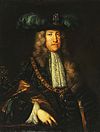
|

|
8 December 1565 Owidal Son of Ulrik and Christina |
Ulrika Wodaner Temple 4 September 1582 4 children |
8 March 1646 Owidal aged 81 |
Son of king Ulrik |
| Matthias Mattias Resvelgen Asieren Nikolson 8 March 1646 – 5 February 1663 (15 years) |
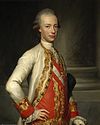
|

|
5 June 1628 Owidal Son of Nicholas I and Ulrika |
Iduna Wodaner Temple 10 March 1647 6 children |
5 February 1663 Owidal aged 35 |
Son of king Nicholas I |
| Oscar Oskar Adelgaard Frigg Mattiasson 5 February 1663 – 12 March 1715 (52 years) |

|

|
2 January 1648 Owidal Son of Mattias and Iduna |
Elisabet Wodaner Temple 10 March 1673 3 children |
12 March 1715 Owidal aged 67 |
Son of king Matthias |
| Christian II Kristiaan II Agnarr Erik Oskarsson 12 March 1715 – 25 November 1778 (63 years) |

|

|
7 September 1702 Owidal Son of Oscar and Elisabet |
Juliana Wodaner Temple 10 March 1730 2 children |
25 November 1778 Owidal aged 76 |
Son of King Oscar |
| Nicholas II Nikolaas II Hildebran Erik Krisson 25 November 1778 – 6 May 1828 (50 years) |

|

|
9 June 1753 Owidal Son of Christian II and Juliana |
Sonja Wodaner Temple 10 March 1774 6 children |
6 May 1828 Owidal aged 75 |
Son of King Christian II |
| Christian III Kristiaan III Alexander Siegfried Nikolson 6 May 1828 – 20 January 1884 (56 years) |

|

|
16 May 1797 Rökavik Royal Estate Son of Nicholas II and Sonja |
Alexia Wodaner Temple 5 August 1805 5 children |
20 February 1884 Owidal aged 87 |
Son of Nicholas II |
| Amalia Amalia Juliana Krisdotter 20 February 1884 – 11 December 1928 (44 years) |

|

|
8 January 1849 Owidal Daughter of Christian III and Alexia |
Charles Wodaner Temple 3 June 1879 No children |
28 May 1934 Owidal aged 85 |
Daughter of King Christian III |
| Estelle Estelle Elisbet Agnes Amadotter 11 November 1928 – 7 October 1953 (25 years) |
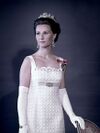
|

|
14 December 1889 Owidal Daughter of Queen Amalia and Prince William |
Princess Ingrid Alina Wodaner Temple 26 July 1930 |
Living Age 70 years |
Daughter of Queen Amalia |
| Kristoffer Kristoffer Seger Esterson 7 October 1953 – Present (7 years) |

|

|
18 April 1928 Rökavik Son of Nicholas Alexander and Ingrid Bergstrom, adopted by Estelle |
Elena of Hellona Wodaner Temple 20 November 1958 |
Living Age 31 years |
Adopted son of Queen Estelle |
